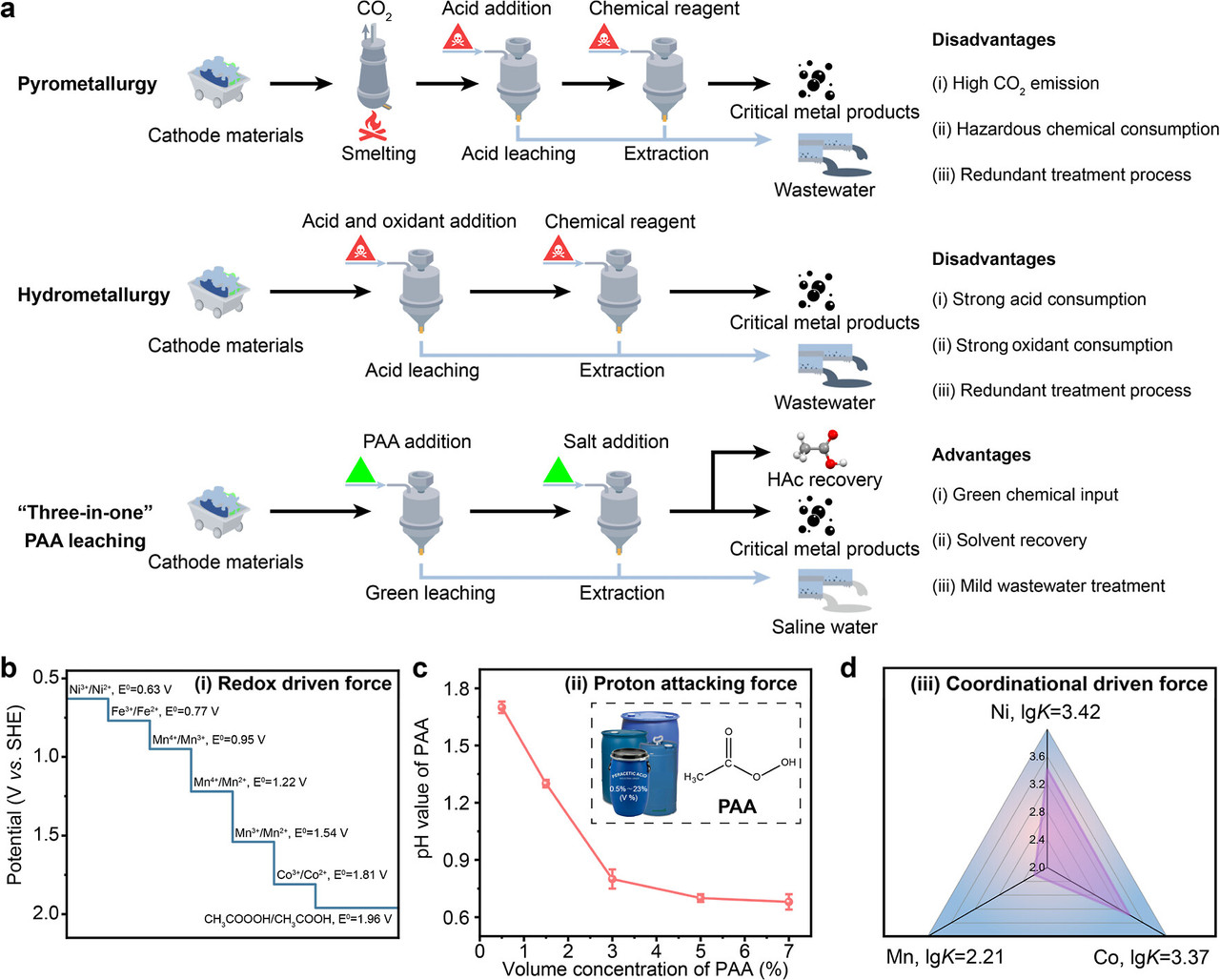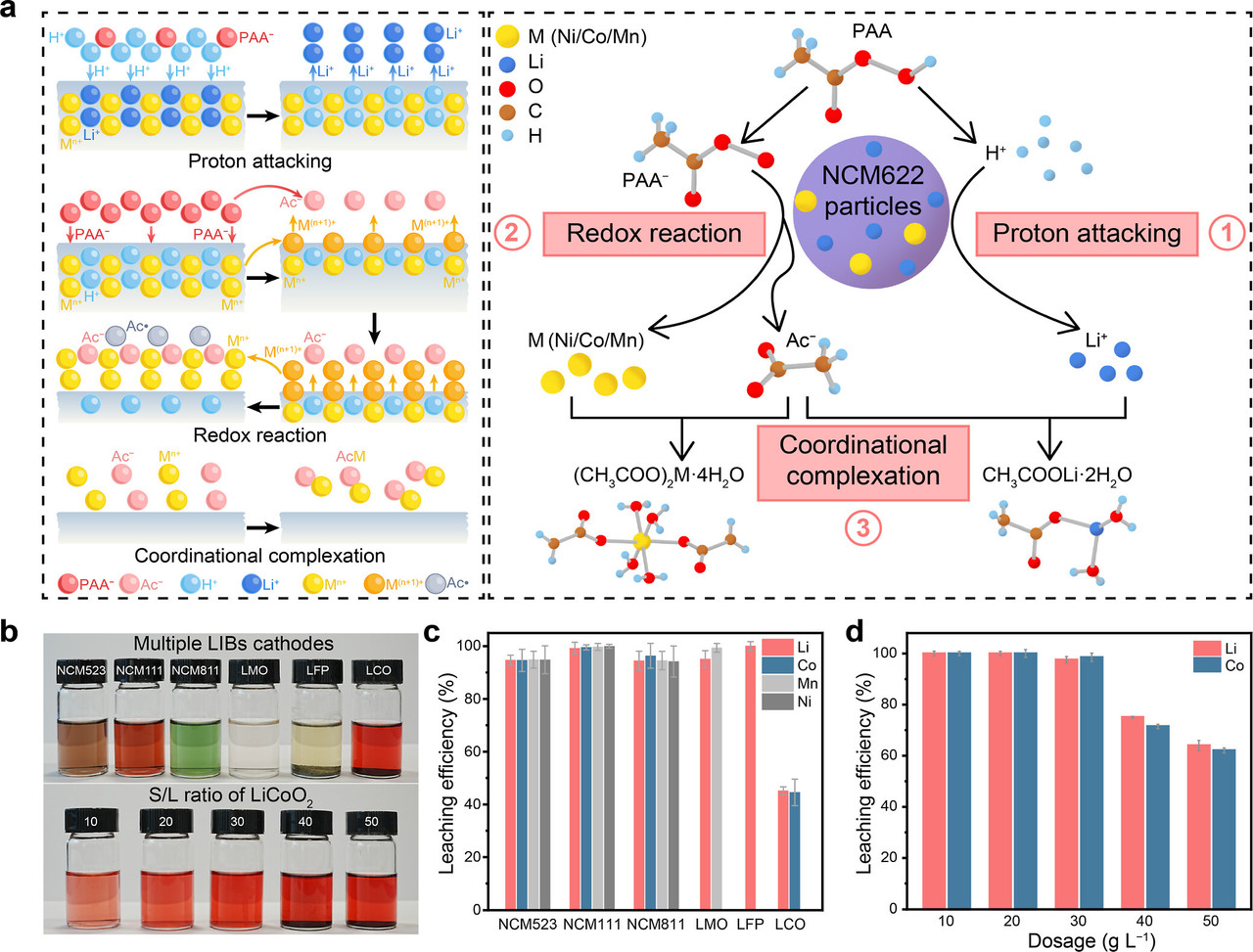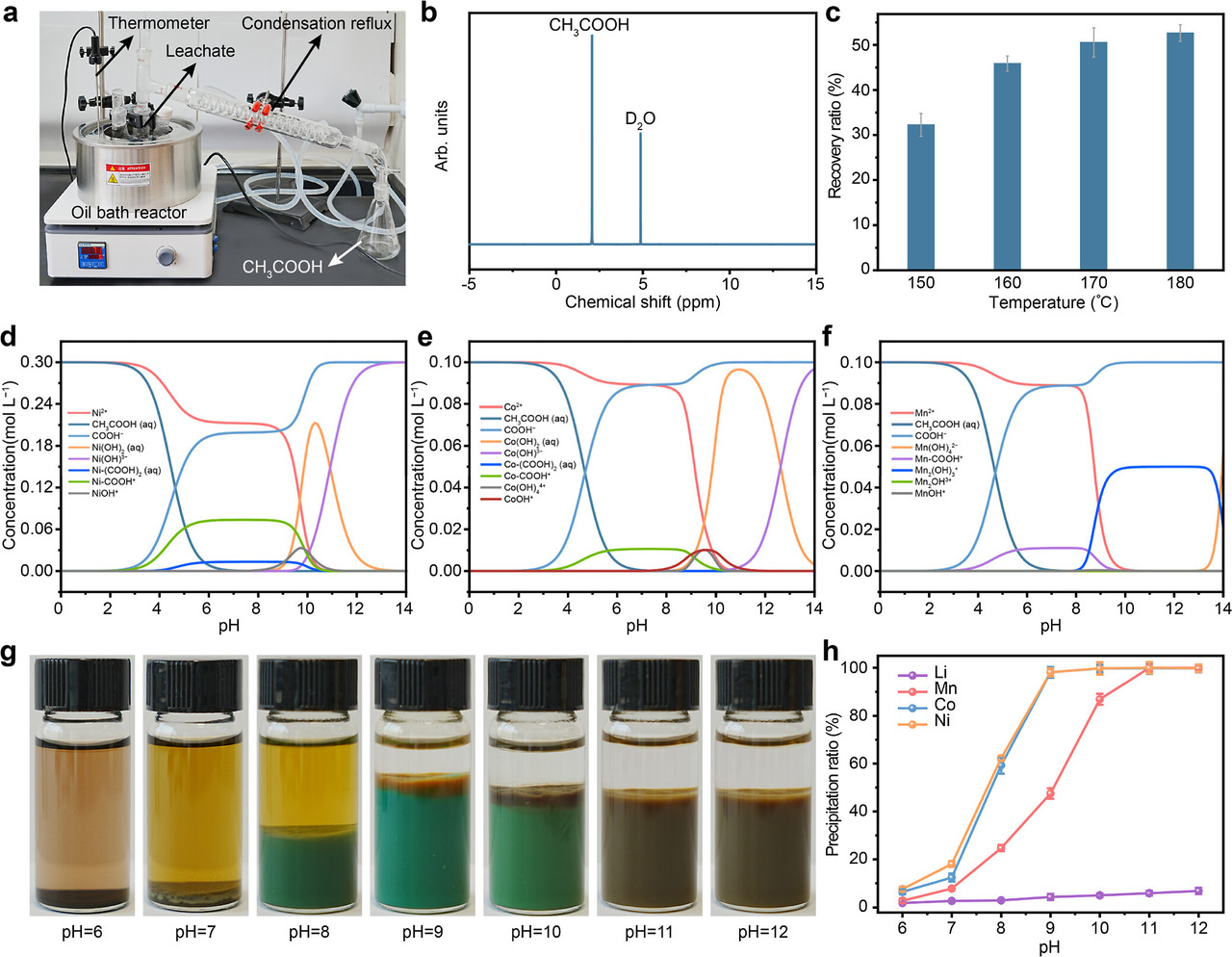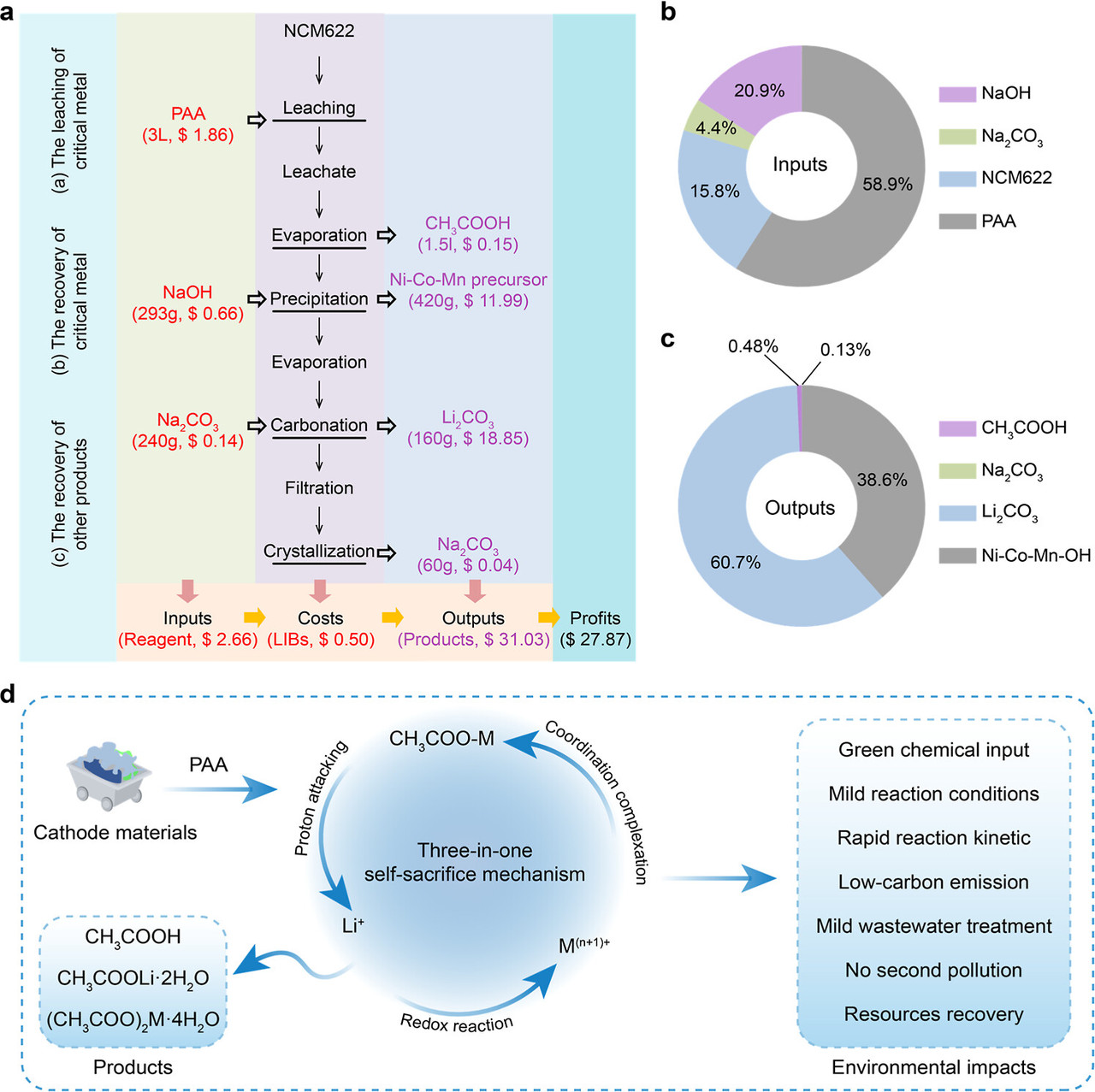Environment & Energy
Related: About this forumEfforts to Reduce the High Energy, Carbon and Chemical Waste Cost of Recycling Lithium Ion Batteries.
The paper I'll briefly discuss in this post is this one: Three-in-One Self-Sacrifice Mechanism Driving Green and Universal Critical Metals Leaching from Spent Lithium-Ion Batteries Xiaonan Feng, Xiaosong Gu, Qiang Zeng, Xuezhen Feng, Yangzi Shangguan, Jiaxin Liang, Jiaxiang Liang, Weixu Zhong, Hao Fan, Qi Yue, Ranhao Wang, and Hong Chen Environmental Science & Technology 2025 59 (45), 24380-24391
The big lie we hear around here from time to time is that energy storage is "green" because allegedly, although not in practice, so called "renewable energy" is "green," even if we address the appalling lack of reliability by storing the energy generated when its not needed.
On inspection, this is nonsense. The land and material costs of so called "renewable energy" are unsustainable, and the use of batteries, concomitant with their material and mining implications, wastes energy, as the inviolable laws of thermodynamics unambiguously indicate.
Batteries themselves have a huge environmental impact; the chemistry is not clean, as the article shows, even with magical "recycling" because recycling isn't "green."
From the article's introduction:
Cathodes with high-density critical metals are the most valuable component in spent LIBs. (6) To recycle critical metals from the spent cathode, pyrometallurgy and hydrometallurgy methods are extensively employed for the recycling of spent LIBs. (7) Meanwhile, the pyrometallurgy approach requires a pyrolysis treatment at high temperatures, resulting in higher energy consumption, severe CO2 emissions, and secondary pollution. (8) In contrast, the hydrometallurgical process, which involves massive amounts of hazardous acid or potent redox agents shipped long distances and then used in wet-chemistry leaching, has been extensively employed in spent cathode recycling. (9−11) Despite the high leaching efficiency, the hazardous nature of acid or oxidizing agents may cause substantial adverse environmental and health effects, resulting in excess wastewater or air pollution and leading to severe health and safety issues (Figure 1a). (12−14) In this regard, developing green and environmentally friendly solvents for the universal and sustainable leaching of critical metals from LIBs is urgently needed. Under these circumstances, mild and green extraction solvents such as hydrogen peroxide (H2O2), sodium sulfite (Na2SO3), persulfate, and deep-eutectic solvents (DES) have been recognized as greener reagents, recently being explored for cathode leaching. (15,16) For instance, a deep eutectic solvent composed of chloroacetic acid and ethanol, with oxygen as the oxidant, has been applied for the recovery of lithium from spent LiFePO4 (LFP) powder. (17) In addition, sulfites and sodium persulfate have been employed as oxidants to selectively extract lithium from spent LiCoO2 (LCO) and LiMn2O4 (LMO), respectively. (18,19) Unfortunately, their high cost and low universality hinder their broad application for recycling diverse types of spent LIB cathodes.
Herein, to develop a green and universal agent for critical metal recycling from multiple types of LIBs cathodes, we employed a multifunctional peracetic acid (PAA) for highly efficient critical metal extraction from different spent cathodes (Figure 1a). Benefiting from the high redox potentials, (20) acidic proton attacking, and coordination function (denoted as three-in-one driven forces) from the carboxyl group, PAA undergoes a self-sacrifice process and delivers a highly efficient critical metal recovery from multiple types of cathodes, including LFP, LCO, LMO, and LiNixCoyMn1–x–yO[sub[2 (NCM). Furthermore, acetic acid (HAc) could be recovered from wastewater after critical metal precipitation, thereby enabling solvent recycling and contributing to a closed-loop wastewater treatment process. Employing PAA as the green critical metal extraction reagent here demonstrates a novel, integrated three-in-one self-sacrifice mechanism for universal critical metal leaching, which is technically important for the circular economy and closed-loop resource utilization of urban mines.
We're saved.
(The next paper in this issue questions whether there is really enough metal to mine on the planet to make all this magical batteries, but I won't have time to go there tonight, or maybe even at any point in the future.)
Some figures from the paper:
The first refers to the state of the art and the proposed modification:

The caption:

The caption:

The caption:

The caption:

The caption:
The author's offer up their concluding claims:
We're saved, especially if we can find lots of poor people to run these processes.
Have a nice day tomorrow.
Finishline42
(1,159 posts)Redwood Materials.
Across the U.S., there are over 9,000 auto recyclers and dismantlers, often referred to as ‘secondary handlers’ who process a variety of vehicles. Now with EVs, they’re on the front lines of removing and identifying battery packs. We partner with them to make sure they have the right tools, training, and support to identify battery packs and help transport them safely to Redwood. From there, our team determines the best path forward: some batteries still have enough life to be remanufactured or reused, while others are ready to be recycled. We recover more than 95% of the critical minerals inside – like lithium, cobalt, nickel, and copper - and return these elements to the supply chain, reducing reliance on mining and keeping materials local.
Today, Redwood receives the vast majority of EV packs and other lithium-ion batteries in North America, and we’re building a circular supply chain alongside dismantlers, dealers, and automakers across the industry. In 2024, we recycled more than 20 GWh of lithium-ion batteries, enough to power over 250,000 new electric vehicles.
The auto recycling community has been safely processing vehicles for more than a century, and EVs are no different. What’s changed is that every battery now holds critical minerals we can recover and reuse—helping strengthen the domestic supply chain and reduce our reliance on mining and imports. Together, we’re turning end-of-life vehicles into a new beginning for American industry.
Link to where the above was copied >>> https://www.redwoodmaterials.com/news/from-road-to-redwood-electric-vehicle-battery-recovery/
Today, Redwood receives over 20 GWh of batteries each year—the equivalent of 250,000 EVs—representing roughly 90% of all lithium-ion batteries recycled in North America.
https://www.redwoodmaterials.com/energy/
NNadir
(36,979 posts)It's not like the marketeers selling this scheme are advertising how the batteries are recycled. There are thousands upon thousands of papers published every year about the health and environmental impacts of recycling schemes on a scale of millions of tons for everything.
The article referenced in this post discusses magical battery recycling and still reports that in their opinion, mining the hell out of the planet will not make the thermodynamic nightmare of batteries sustainable. The land that can be mined for this affectation are limited. The environmental impact of mining his huge. This is why energy density and lifetime of energy systems is important.
I do understand that antinukes like to defend the indefensible materially intense use of batteries can engage in their rote indifference to environmental issues because they're intellectually, morally, and economically incapable of suspending their absurd, irrational, and highly destructive fear of nuclear energy.
I have discussed the film Unearth where mining interests were using so called "renewable energy" as an advertising ploy to destroy Bristol Bay in Alaska:
My wife and I saw the documentary film "Unearth" today.
I'm unimpressed. To my mind, these people excusing the unsustainable aspects so called "renewable energy" are scientifical and industrial engineering illiterates, particularly when they embrace batteries.
After trillions of dollars squandered on solar and wind, combined they produced in 2024, just 18 Exajoules of energy combined, out of 654 EJ of energy consumed by humanity on this planet.
The scam has left the planet in flames.